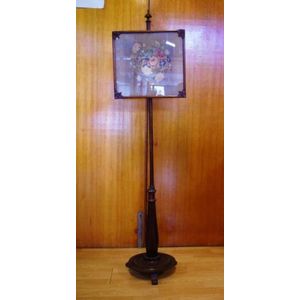Regency Mahogany Two Tier Serving Table
You must be a subscriber, and be logged in to view price and dealer details.
Subscribe Now to view actual auction price for this item
When you subscribe, you have the option of setting the currency in which to display prices to $Au, $US, $NZ or Stg.
- Turning - Any part of a piece of furniture that has been turned and shaped with chisels on a lathe. Turned sections include legs, columns, feet, finials, pedestals, stretchers, spindles etc. There have been many varieties and fashions over the centuries: baluster, melon, barley-sugar, bobbin, cotton-reel, rope-twist, and so on. Split turning implies a turned section that has been cut in half lengthwise and applied to a cabinet front as a false decorative support.
- Tier - One or more under-shelves of a table or cabinet.
- Apron - A decorative wooden panel that sits underneath the top surface of a table or chair, and unites the top of the piece with the legs, running at right angles to the underside. On carcase furniture such as a chest or wardrobe, the apron sits below the drawers or doors and attaches to the legs.
On carcase furniture without legs the panel under the drawers or doors sits on the floor and is termed a plinth.
An apron can provide a decorative touch to an otherwise unadorned piece of furniture and at the same time provide structural support and strength. They can be carved or pierced and quite elaborate. - Regency Period - The Regency period in English furniture design refers to the period when King George III, was declared unfit to rule in 1811, and his son ruled as proxy as Prince Regent, until 1820, and then, after the death of his father as George IV until his death in 1830. The Regency period was preceded by the Georgian period (George I, George II, and George III: 1714 - 1811), and was followed by the William IV period, which only lasted until 1837 when William IV died as was succeeded by Queen Victoria.
- Mahogany - Mahogany is a dense, close grained red-coloured timber from the West Indies and Central America. It was first imported into Europe in the the early 18th century and its use continued through the 19th century. It was popular for furniture making because of its strength, the wide boards available, the distinctive grain on some boards, termed flame mahogany and the rich warm colour of the timber when it was polished.. The "flame" was produced where a limb grew out from the trunk of the tree, and this timber was usually sliced into veneers for feature panels on doors, backs and cornices.
Some terms used to describe mahogany relate to the country from which it originally came, such as "Cuban" mahogany, "Honduras" mahogany etc. However unless the wood has been tested the names assigned are more a selling feature, rather than a true indication of the timber's origin.
This item has been included into following indexes:
Visually similar items

A small Royal Worcester rose decorated vase, 1918, the ovoid vase with a slender trumpet neck and foot embellished with shot gilt colours, decorated to the body with full blown deep pink roses with foliage upon a suffused pastel ground; puce backstamp unde

Edwardian walnut tapestry and velvet upholstered salon suite, circa 1910

Victorian mahogany pole screen, with needlework floral bouquet panel, The British Antique Dealers Association seal to base

Late 19th century Austro-Hungarian 900 silver ladle, approx. 97gr
